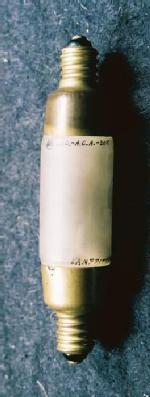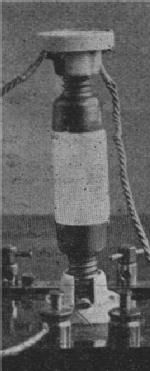Radio-Katalog, Röhren, Halbleiter etc.
Receiving
|
Land:
Niederlande
|
|
| Identisch mit |
Receiving
|
| Erste
Serie |
1918
Saga of the Vacuum Tube, Tyne page 271
|
| Produktionsende |
Nov.1920 |
| Sockel |
Sockel an beiden Enden.
|
| Heizung |
Direkt |
| Beschreibung |
The Bal receiving tubes were made by Pope in Venlo in 1918 and 1919. In 1920 the Bal receiving tubes were made by Philips. The Philips made tubes are identical to the Philips C1 and C2 and Ideezet types and have Philips etched on the glass an printed "Bal radio, Breda Holland" printed on one of the bases. The Pope and Philips made tubes have the electrode structure of a deForest double wing Audion. But the Philips made tubes have very tight specifications as for seize, while the Pope made tubes differ very much in seize and have sometimes frosted glass. Philips used always metal strips as support rods to the plates, where Pope used wires.
|
Abmessungen (BHT)
inkl. Stifte/Spitzli |
25 x 122 x mm / 0.98 x 4.80 x inch |
| Gewicht |
26 g / 0.92 oz |
Sammlung von
|
|
|
Varianten
 Filament 4 Volt - 0.8 Amp.used in the first Avia reciver/transmitter. Diameter 27 mm, length 130 mm.
Filament 4 Volt - 0.8 Amp.used in the first Avia reciver/transmitter. Diameter 27 mm, length 130 mm.
|
|
 Diameter 26 mm, length 113 mm, no data available.
Diameter 26 mm, length 113 mm, no data available.
|
|
 Filament 4 Volt, 0,5 Amp. Low vacuum max 30 anode voltage. Length 115 mm, diameter 23 mm.
Filament 4 Volt, 0,5 Amp. Low vacuum max 30 anode voltage. Length 115 mm, diameter 23 mm.
|
|
 Filament 4 Volt. No further data. Length 119, diameter 24 mm.
Filament 4 Volt. No further data. Length 119, diameter 24 mm.
|
|
 the first Bal receiving tube, made by Pope
Frosted glass, no data available. March 1918.
the first Bal receiving tube, made by Pope
Frosted glass, no data available. March 1918.
|
|
|
|
|
|
[rmxtube-ge, noindex]
| Datenkonformität |
Mehr Informationen |
|
|
|

